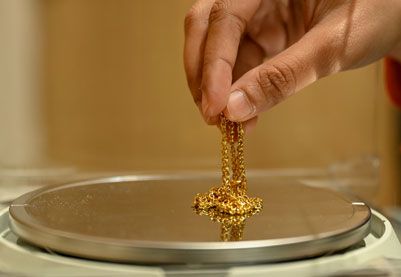Rs. 5,000 - Rs. 2 crore
To find the nearest gold loan branch,
Enter phone and OTP | Check amount you can get | Apply for quick funds
What is rose gold and why is it popular?
Rose gold is a stunning metal alloy known for its warm, pinkish hue, created by blending pure gold with copper and a small amount of silver. This combination not only gives it a unique colour but also enhances its durability. Unlike traditional yellow or white gold, rose gold has a vintage yet modern appeal, making it a popular choice in jewellery, especially for engagement rings, watches, and designer accessories.
One of the main reasons for its popularity is its versatility. Rose gold complements all skin tones and pairs beautifully with other metals, allowing for creative and stylish jewellery designs. It also symbolises romance and elegance, making it a preferred option for wedding jewellery.
Additionally, rose gold is more durable than pure gold due to the strength of copper, making it resistant to scratches and wear. Unlike white gold, which requires rhodium plating to maintain its shine, rose gold retains its natural lustre over time.
The growing preference for rose gold in fashion, technology, and luxury items has further cemented its status as a timeless and trendy choice. Whether in jewellery or accessories, rose gold continues to captivate with its distinctive charm and elegance.
How is rose gold different from other types of gold?
Rose gold is special because of its lovely pinkish-red colour, which comes from mixing gold with copper. The more copper it contains, the deeper and richer the shade appears. This warm tone gives rose gold a romantic and vintage charm.
Yellow gold, in comparison, keeps its bright golden look because it is mixed with metals like silver and zinc. White gold, on the other hand, is blended with nickel or palladium and coated with rhodium to create a shiny silvery finish. However, white gold usually needs re-plating over time, while rose gold naturally keeps its colour.
Another big difference is strength. Thanks to the copper mix, rose gold is tougher than yellow and white gold, making it more resistant to scratches. That is why many people prefer rose gold for rings or daily-wear jewellery. Its timeless yet modern look makes it a favourite for those who want something stylish and unique.
What metals are mixed to create rose gold?
Rose gold is an alloy made by blending pure gold with copper and sometimes a small amount of silver. The combination of these metals determines the final shade and durability of rose gold. A typical composition for 18K rose gold is 75% gold, 22.5% copper, and 2.5% silver, while 14K rose gold contains about 58.5% gold and a higher percentage of copper, giving it a deeper pink hue.
Copper is the primary metal responsible for rose gold’s signature warm, reddish-pink tint. The higher the copper content, the more intense the pinkish hue. Silver is occasionally added to soften the colour and balance the overall composition, ensuring a pleasing blend.
The use of copper not only enhances the colour but also improves the strength of the gold, making rose gold more durable than yellow or white gold. This added strength makes it resistant to wear and scratches, making it a practical choice for jewellery that sees frequent use.
Since rose gold contains copper, it may develop a patina over time, giving it an antique look that many people find appealing. However, regular polishing can restore its shine. With its perfect blend of beauty and durability, rose gold remains a sought-after choice for fine jewellery.
Quick tip: Curious about your loan eligibility? Enter your mobile number to see how much you can get for your gold.
What is rose gold made of?
Rose gold is primarily made of gold, copper, and silver. The alloy typically consists of 75% gold, 22.5% copper, and 2.5% silver. The copper content provides the reddish-pink hue, while the silver enhances its brightness. This combination results in the distinctive warm and rosy appearance that characterises rose gold jewellery.
Can rose gold be pledged?
Yes, rose gold can be pledged to obtain a gold loan. Most lenders accept rose gold along with other types of gold jewellery as collateral for gold loans. However, the loan amount is determined based on the gold's purity and weight, so it's essential to assess these factors before pledging. Ensure the rose gold meets the lender's criteria for purity and quality. Once evaluated, you can pledge your rose gold to secure a gold loan, providing you with access to funds while retaining ownership of your jewellery.
Please note: Bajaj Finance does not accept rose gold for gold loan. You can only pledge your 18-22 karat gold jewellery to avail a gold loan of up to Rs. 2 crore at competitive gold loan interest rates and multiple repayment options.
What colour is rose gold?
Rose gold exhibits a soft, warm hue characterized by a pinkish or reddish tint. This colour results from the combination of gold with copper and occasionally silver. The proportion of copper in the alloy determines the intensity of the pink tone, ranging from subtle blush to deep rose. The addition of silver may impart a slightly lighter or brighter appearance. Rose gold's delicate and romantic hue has made it a popular choice for jewellery and accessories, adding a touch of elegance and sophistication to various fashion pieces.
Is rose gold real gold?
Yes, rose gold is real gold. It's a gold alloy made by mixing pure gold with copper and sometimes silver. The copper content gives rose gold its distinct pinkish hue, while the silver can enhance its brightness. The purity of rose gold is measured in carats, just like yellow or white gold. Typically, rose gold jewellery is made with 18 carat gold or 14 carat gold, indicating the percentage of pure gold in the alloy. While it's not as pure as 24-carat gold, which is 99.9% gold, rose gold retains the valuable properties of gold while offering a unique colour and aesthetic appeal.
Difference between rose gold, yellow gold and white gold
| Aspect | Rose Gold | Yellow Gold | White Gold |
| Composition | Gold alloyed with copper and sometimes silver | Gold alloyed with copper and silver | Gold alloyed with nickel, zinc, or palladium |
| Colour | Pinkish hue | Yellow hue | Silver or white hue |
| Durability | Less durable than yellow or white gold | More durable than rose gold, similar to white gold | More durable than rose gold, similar to yellow gold |
| Common purity | 18K (75% gold), 14K (58.3% gold) | 18K (75% gold), 14K (58.3% gold) | 18K (75% gold), 14K (58.3% gold) |
| Popularity | Increasing popularity due to unique colour | Classic choice, traditional | Modern alternative, gaining popularity |
How to clean rose gold jewellery?
Cleaning rose gold jewellery requires some care to maintain its shine and luster. What is rose gold? It’s a blend of gold with copper and sometimes silver, giving it a unique pink hue. Rose gold, what is it used for? Its elegant colour makes it popular in fine jewellery. To clean rose gold, start by mixing a few drops of mild dish soap with warm water. Soak the jewellery for 15-20 minutes, then gently brush with a soft toothbrush to remove dirt. Rinse thoroughly with clean water and dry with a soft cloth. What is rose gold metal made of? Its copper content makes it more prone to tarnishing, so regular cleaning helps maintain its appearance. Avoid harsh chemicals to prevent damage.
Pro tip: Manage planned to urgent expenses with ease. Check your gold loan eligibility now and make your gold work for your needs.
Why is rose gold so famous?
What is rose gold? It’s a stunning blend of gold and copper that gives it a distinctive pinkish hue. Rose gold, what is it known for? Its unique colour and warmth have made it increasingly popular in fashion and jewellery. What is rose gold metal composed of? Typically, it combines yellow gold with a higher percentage of copper, which enhances its rosy tint. This combination creates a sophisticated and timeless look, making it a favoured choice for engagement rings, watches, and other fine jewellery. Its versatility and romantic appeal have contributed to its enduring popularity in the world of fashion and design.
Where did rose gold come from?
What is rose gold? It is a precious metal alloy that combines gold with copper, giving it a distinctive pinkish hue. The history of rose gold dates back to the 19th century when it was first popularised by Russian jeweller Carl Fabergé. Rose gold, what is it exactly? It’s an alloy created by blending yellow gold with copper, which imparts its unique color. What is rose gold metal composed of? Typically, it consists of 75% gold and 25% copper, although the exact proportions can vary. Its warm, rosy tone has gained popularity for its elegance and versatility in modern jewellery, continuing to charm with its classic appeal.
Can you pawn or get a loan against rose gold jewellery?
Yes, you can pawn or get a loan against rose gold jewellery, just like traditional gold. Financial institutions and pawn shops accept rose gold as collateral, but the loan amount depends on its gold content. Since rose gold is an alloy containing copper and silver, its value is calculated based on the percentage of pure gold present, typically 14K or 18K.
When applying for a loan against rose gold, lenders assess factors such as weight, purity, and the current gold price. However, rose gold jewellery may fetch slightly lower loan amounts than yellow or white gold due to its alloy composition. It is essential to check the lender’s policies and compare interest rates to secure the best deal.
Bajaj Finserv Gold Loan offers competitive rates and a hassle-free process for loans against gold jewellery. Checking today’s gold loan rate can help you determine the best time to apply for maximum benefits.
Factors that affect the value of rose gold for loans
When you use rose gold as collateral for a loan, its value depends on a few important factors.
- Purity of gold: The karat (K) makes a big difference. For example, 18K rose gold has more pure gold and gets a better value compared to 14K, which has more copper.
- Weight of jewellery: Only the gold portion is considered for valuation, while gemstones or designs are excluded.
- Current gold rate: The gold market rate on the day of your application decides the final value since prices change daily.
- Lender’s policy: Some lenders may offer lower loan-to-value ratios on rose gold. Choosing a trusted option like Bajaj Finserv Gold Loan ensures fair valuation and a smooth process.
How to check the purity of rose gold before taking a loan
Before taking a loan against rose gold jewellery, it is essential to verify its purity to ensure you receive the best possible loan amount. One of the most reliable ways to check purity is by looking for the BIS hallmark, which certifies the gold’s authenticity and karatage, such as 18K or 14K.
You can also visit a certified jeweller or lender with gold purity testing equipment, such as an XRF analyser, to determine the exact gold content. Another simple method is the acid test, where a jeweller applies a mild acid to a small scratch on the jewellery to check its reaction and purity level.
Lenders typically conduct their own purity tests before approving a loan. Choosing a trusted financial institution, such as gold loan from Bajaj Finance, ensures transparency in the evaluation process. Checking the today’s gold loan rate beforehand can also help you maximise your loan amount.
Turn your gold into instant support—handle any expense with ease. Check your gold loan eligibility and access funds when you need them most.
Gold loan eligibility criteria
Getting a Bajaj Finserv Gold Loan against your rose gold jewellery is simple and stress-free. The eligibility rules are very straightforward. You only need to be an Indian citizen between 21 to 80 years old and have rose gold jewellery of 18-22 purity or higher. There is no need to worry about a high credit score or long paperwork. If you have rose gold jewellery to pledge, you can quickly qualify and access funds with ease.
Checking your gold loan eligibility takes just 2 steps. Simply enter your mobile number, and you are all set to explore how much value your rose gold jewellery can unlock through a Bajaj Finserv Gold Loan.
How to apply for a gold loan with Bajaj Finance
Applying for a Bajaj Finserv Gold Loan with your rose gold jewellery is quick and hassle-free. You can either visit the nearest branch with your rose gold pieces and valid KYC documents. The team will verify the purity and weight of your jewellery, calculate your eligible loan amount, and process it on the spot. In most cases, the funds are credited to your account the same day, so you can access money exactly when you need it.
For extra convenience, you can also apply online through the Bajaj Finserv App or website. This way, whether you prefer visiting a branch or applying from home, getting a loan against your rose gold jewellery is simple, fast, and stress-free.
Ready to unlock the value of your gold? Apply for Bajaj Finserv Gold Loan today.
Related Articles
Disclaimer
Bajaj Finance Limited has the sole and absolute discretion, without assigning any reason to accept or reject any application. Terms and conditions apply*.









 Personal Loan
Personal Loan Check Eligibility
Check Eligibility Salaried Personal Loan
Salaried Personal Loan EMI Calculator
EMI Calculator Account Aggregator
Account Aggregator Credit Pulse Report
Credit Pulse Report
 Deals starting @99
Deals starting @99 Festive deals
Festive deals Min. 50% off
Min. 50% off
 Wallet to Bank
Wallet to Bank
 Easy EMI Loan
Easy EMI Loan Savings Offer
Savings Offer Smartphones
Smartphones Led TVs
Led TVs Washing Machines
Washing Machines Laptops
Laptops Refrigerators
Refrigerators Air Conditioner
Air Conditioner Air Coolers
Air Coolers
 Loan Against Shares
Loan Against Shares Loan Against Mutual Funds
Loan Against Mutual Funds Loan Against Insurance Policy
Loan Against Insurance Policy ESOP Financing
ESOP Financing Easy EMI Loan
Easy EMI Loan Two-wheeler Loan
Two-wheeler Loan Loan for Lawyer
Loan for Lawyer Industrial Equipment Finance
Industrial Equipment Finance Industrial Equipment Balance Transfer
Industrial Equipment Balance Transfer Industrial Equipment Refinance
Industrial Equipment Refinance Personal Loan Branch Locator
Personal Loan Branch Locator Used Tractor Loan
Used Tractor Loan Loan Against Tractor
Loan Against Tractor Tractor Loan Balance Transfer
Tractor Loan Balance Transfer
 Two-wheeler Loan
Two-wheeler Loan Bike
Bike Scooter
Scooter Electric Vehicle
Electric Vehicle Best Sellers
Best Sellers Popular Brands
Popular Brands

 Trading Account
Trading Account Open Demat Account
Open Demat Account Margin Trading Financing
Margin Trading Financing Share Market
Share Market Invest in IPO
Invest in IPO All stocks
All stocks Top gainers
Top gainers Top losers
Top losers 52 week high
52 week high 52 week low
52 week low Loan against shares
Loan against shares
 Home Loan
Home Loan Transfer your existing Home loan
Transfer your existing Home loan Loan against Property
Loan against Property Home Loan for Salaried
Home Loan for Salaried Home loan for self employed
Home loan for self employed Home Loan EMI Calculator
Home Loan EMI Calculator Home Loan eligibility calculator
Home Loan eligibility calculator Home Loan balance transfer
Home Loan balance transfer
 Term Life Insurance
Term Life Insurance ULIP Plan
ULIP Plan Savings Plan
Savings Plan Family Insurance
Family Insurance Senior Citizen Health Insurance
Senior Citizen Health Insurance Critical Illness Insurance
Critical Illness Insurance Child Health Insurance
Child Health Insurance Pregnancy and Maternity Health Insurance
Pregnancy and Maternity Health Insurance Individual Health Insurance
Individual Health Insurance Low Income Health Insurance
Low Income Health Insurance Student Health Insurance
Student Health Insurance Group Health Insurance
Group Health Insurance Retirement Plans
Retirement Plans Child Plans
Child Plans Investment Plans
Investment Plans
 Business Loan
Business Loan Secured Business Loan
Secured Business Loan Loan against property
Loan against property Loans against property balance transfer
Loans against property balance transfer Loan against shares
Loan against shares Home Loan
Home Loan Loans against mutual funds
Loans against mutual funds Loan against bonds
Loan against bonds Loan against insurance policy
Loan against insurance policy
 Apply for Gold Loan
Apply for Gold Loan Transfer your Gold Loan with Us
Transfer your Gold Loan with Us Gold Loan Branch Locator
Gold Loan Branch Locator
 ULIP Plan
ULIP Plan Savings Plan
Savings Plan Retirement Plans
Retirement Plans Child Plans
Child Plans Free Demat Account
Free Demat Account Invest in Stocks
Invest in Stocks Invest in IPO
Invest in IPO Margin Trading Facility
Margin Trading Facility Fixed Deposit Branch Locator
Fixed Deposit Branch Locator
 Check your Credit Score
Check your Credit Score
 New Car Loan
New Car Loan Used Car Loan
Used Car Loan Loan Against Car
Loan Against Car Car Loan Balance Transfer and Top-up
Car Loan Balance Transfer and Top-up
 Get Bajaj Prime
Get Bajaj Prime
 Mobiles on EMI
Mobiles on EMI Electronics on EMI Offer
Electronics on EMI Offer  Iphone on EMI
Iphone on EMI LED TV on EMI
LED TV on EMI Refrigerator on EMI
Refrigerator on EMI Laptop on EMI
Laptop on EMI Kitchen appliances on EMI
Kitchen appliances on EMI Washing machines
Washing machines
 Personal Loan EMI Calculator
Personal Loan EMI Calculator Personal Loan Eligibility Calculator
Personal Loan Eligibility Calculator Home Loan EMI Calculator
Home Loan EMI Calculator Home Loan Eligibility Calculator
Home Loan Eligibility Calculator Good & Service Tax (GST) Calculator
Good & Service Tax (GST) Calculator Flexi Day Wise Interest Calculator
Flexi Day Wise Interest Calculator Flexi Transaction Calculator
Flexi Transaction Calculator Secured Business Loan Eligibility Calculator
Secured Business Loan Eligibility Calculator Fixed Deposits Interest Calculator
Fixed Deposits Interest Calculator Two wheeler Loan EMI Calculator
Two wheeler Loan EMI Calculator New Car Loan EMI Calculator
New Car Loan EMI Calculator Used Car Loan EMI Calculator
Used Car Loan EMI Calculator All Calculator
All Calculator Used Tractor Loan EMI Calculator
Used Tractor Loan EMI Calculator
 Hot Deals
Hot Deals Clearance Sale
Clearance Sale Kitchen Appliances
Kitchen Appliances Tyres
Tyres Camera & Accessories
Camera & Accessories Mattresses
Mattresses Furniture
Furniture Watches
Watches Music & Audio
Music & Audio Cycles
Cycles Mixer & Grinder
Mixer & Grinder Luggage & Travel
Luggage & Travel Fitness Equipment
Fitness Equipment Fans
Fans
 Personal Loan for Doctors
Personal Loan for Doctors Business loan for Doctors
Business loan for Doctors Medical Equipment Finance
Medical Equipment Finance Secured Business Loan
Secured Business Loan Loan against property
Loan against property Secured Business Loan Balance Transfer
Secured Business Loan Balance Transfer Loan against share
Loan against share Gold Loan
Gold Loan Home Loan
Home Loan
 Engagement Zone
Engagement Zone Game Zone
Game Zone
 Savings Offer
Savings Offer Easy EMI
Easy EMI Offer World
Offer World 1 EMI OFF
1 EMI OFF New Launches
New Launches Zero Down Payment
Zero Down Payment Clearance Sale
Clearance Sale Bajaj Mall Sale
Bajaj Mall Sale
 Mobiles under ₹20,000
Mobiles under ₹20,000 Mobiles under ₹25,000
Mobiles under ₹25,000 Mobiles under ₹30,000
Mobiles under ₹30,000 Mobiles under ₹35,000
Mobiles under ₹35,000 Mobiles under ₹40,000
Mobiles under ₹40,000 Mobiles under ₹50,000
Mobiles under ₹50,000
 Articles
Articles
 Overdue Payments
Overdue Payments Other Payments
Other Payments
 Document Center
Document Center Bank details & Documents
Bank details & Documents Tax Invoice Certificate
Tax Invoice Certificate
 Do Not Call Service
Do Not Call Service
 Hamara Mall Orders
Hamara Mall Orders

 Check Loan Offer
Check Loan Offer Mobiles on EMI
Mobiles on EMI Trade directly with your Demat A/c
Trade directly with your Demat A/c ITR
ITR My Garage
My Garage
 Live Videos - Beta
Live Videos - Beta
 Savings Offer
Savings Offer Smartphones
Smartphones LED TVs
LED TVs Washing Machines
Washing Machines Laptops
Laptops Refrigerators
Refrigerators Air Conditioners
Air Conditioners Air Coolers
Air Coolers Water Purifiers
Water Purifiers Tablets
Tablets Kitchen Appliances
Kitchen Appliances Mattresses
Mattresses Furniture
Furniture Music and Audio
Music and Audio Cameras & Accessories
Cameras & Accessories Cycle
Cycle Watches
Watches Tyres
Tyres Luggage & Travel
Luggage & Travel Fitness Equipment
Fitness Equipment Tractor
Tractor Easy EMI Loan
Easy EMI Loan
 vivo Mobiles
vivo Mobiles OPPO Mobiles
OPPO Mobiles Xiaomi Mobiles
Xiaomi Mobiles Sony LED TVs
Sony LED TVs Samsung LED TVs
Samsung LED TVs LG LED TVs
LG LED TVs Haier LED TVs
Haier LED TVs Godrej Refrigerators
Godrej Refrigerators Voltas Washing Machines
Voltas Washing Machines









